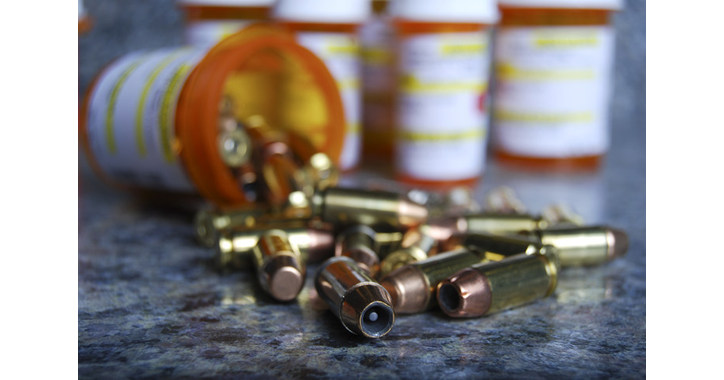LOS ANGELES, Feb. 28, 2018 /PRNewswire/ — The mental health watchdog, Citizens Commission on Human Rights (CCHR) today questioned how the recent suspected Florida school shooter was allowed to join the Douglas Army Junior Reserve Officer Training Corps (JROTC) when he had been prescribed drugs to treat “Attention Deficit Hyperactivity Disorder” (ADHD). Powerful stimulants such as methylphenidate are usually prescribed to treat ADHD, yet these can disqualify an applicant for joining ROTC generally and the Defense Forces.[1] ADHD stimulants such as methylphenidate are documented to cause hallucinations, behavior changes, aggression, abnormal thoughts, sudden outbursts, mood swings and thoughts of suicide.[2]
Since 2014, the Department of Defense’s medical qualification standards regarding these stimulants disqualifies applicants if they have been treated with ADHD drugs within the previous year and/or they displayed signs of ADD/ADHD. Even for applicants off the drugs for more than one year, if they are currently exhibiting “ADHD symptoms,” a medical waiver is required.[3] In 2016, the alleged shooter was in the Junior ROTC where he excelled at shooting and marksmanship, using air rifles. Cadets called him the “wolf.”[4] He was expelled for disciplinary issues in early 2017 and clearly before and during 2016, the shooter had displayed “impulse” issues.
Media reports that the alleged shooter was taking “ADHD medication” at least in 2013 and 2016 and it’s unclear whether this continued and may have also been supplemented by psychotropic drugs prescribed for “depression.” When someone stops taking methylphenidate, within 24 hours, he can experience agitation and mood swings and within 14 days, anxiety, depression, sleep disorders and nervousness. A 2016 study published in JAMA Psychiatry also indicated that methylphenidate has a distinct effect on children that may lead to lasting neurological changes.[5] In another study published in Pediatrics in 2009, Andrew Mosholder, formerly from the Office of Surveillance and Epidemiology, Center for Drug Evaluation and Research, FDA, and others, concluded, “Patients and physicians should be aware that psychosis or mania arising during drug treatment of attention-deficit/hyperactivity disorder may represent adverse drug reactions.”[6]
CCHR, which is compiling a comprehensive report on mass acts violence, found that in a random sample of 28 school-related acts of violence committed by those aged between 12 and 20, the drugs most frequently cited as taken by the perpetrators were the antidepressants fluoxetine (6); venlafaxine (3) and sertraline (2); “ADHD” drugs, including methylphenidate (6); and the sedative-hypnotics or benzodiazepines diazepam, and alprazolam (3).
A timeline on the alleged Florida school shooter’s experience with the mental health system was also posted on CCHR International’s website titled, “Florida School Shooter: Timeline on Mental Health System’s Behavioral and Drug Treatment Failure to Prevent Senseless Violence.” It includes information collected from media reports of the shooter being diagnosed or labeled and treated in the mental health system since the age of four.
This also points to a study where researchers took the Food and Drug Administration (FDA) Adverse Event Reporting System data and of 484 prescription drugs identified, 31 were found to be disproportionately associated with violence. These drugs, accounting for 79 percent of all the violence cases, included 25 psychotropic drugs.[7] The findings, published in Public Library of Science ONE, included 11 antidepressants, six sedative/hypnotics, and three ADHD drugs — supporting what it found in its random sample of school shootings. The specific cases of violence included: homicide, physical assaults, physical abuse, homicidal ideation, and cases described as a violence-related symptom.[8]
Among the drugs associated with the highest rates of violence compared to all drugs were six antidepressants that ranged from 7.9 times higher for sertraline, 8.3 times higher for venlafaxine to 10.9 times more likely for fluoxetine. Two stimulants ranged from 9.0 to 9.6 times more likely to be associated with violence than other prescription drugs.[9]
CCHR reiterated calls for federal and state investigations into the link between psychiatric drugs and violence — a call the group has made since the 1999 Columbine school shooting when a Colorado Ad Hoc government hearing was held into the issue. Then, Colorado State Representative Penn Pfiffner, who chaired the hearing, stated: “There is enough coincidence and enough professional opinion from legitimate scientists to cause us to raise the issue and to ask further questions.” Further, “If we’re only interested in debating gun laws and metal detectors, then we as legislators aren’t doing our job.”[10]
In 2006, Professor David Healy, a leading psychopharmacology expert and professor of psychiatry in Wales, was the lead author of a study which advised: “Legal systems are likely to continue to be faced with cases of violence associated with the use of psychotropic drugs, and it may fall to the courts to demand access to currently unavailable data. The problem is international and calls for an international response.”[11]
Yet, states have failed to act, CCHR said. Yet, the behaviors being reported in the alleged Florida school shooter are not dissimilar to what was reported nearly 20 years ago. Columbine High School shooters, E. Harris and D. Klebold, had a troubled history like the suspected Florida shooter. They were arrested for burglarizing a car and court-ordered to “anger management” class.[12] As graduates of a Jefferson County “diversion program,” Harris described his own “short temper, often get angry at almost anything I don’t like, like people I have no respect for trying to tell me what to do.” Harris also noted he experienced anger, anxiety, depression, disorganized thoughts, homicidal thoughts, jealousy, loneliness, mood swings, obsessive thoughts, racing thoughts, stress, suspiciousness and a temper.[13] Autopsy results revealed Harris had the antidepressant fluvoxamine in his system when he committed suicide.[14] There are many international drug regulatory warnings that link the antidepressant to suicidal behavior, hostility or aggression, agitation, abnormal behavior, mania or psychosis, self-harm, and violence.[15]
Unlike the alleged Florida school shooter who was able to join the ROTC, the Marine Corp rejected Harris when he applied to join after the recruiters found he was taking an antidepressant and seeing a psychiatrist. On a visit to Harris’s home on April 15, 1999, Marine recruiters learned that he had taken the antidepressant, yet had explicitly stated on his application that he did not take any prescription drugs.[16] Five days later, the students staged their own private war at Columbine High School, killing 13 people before they finally killed themselves.
CCHR says that involuntary commitment of Harris, Klebold or the suspected Florida school shooter would not have prevented their murderous rampage and rejects any mental health industry demands for stronger commitment laws. They point to a young man (21), from Austin, Texas, who on May 1, 2017, stabbed four people with a machete-like hunting knife at the University of Texas, killing one and wounding three. The assailant had recently been involuntarily committed in another city and county records showed that he had been arrested and charged with Driving While Intoxicated on April 4, 2017. He was taking two “happy pills,” which the arrest report listed as the antidepressant sertraline.[17]
“Unless states look at the potential for the ‘treatment’ to be a cause of or a contributing factor in violent behavior — especially with such a proliferation of school-aged children and adolescents prescribed psychotropic-psychiatric drugs — acts of violence in schools will likely escalate. The bottom line is psychiatric drugs create violence,” Ms. Jan Eastgate, international president of CCHR, stated.
CCHR provided studies of violent adverse effects attributed to psychotropic drugs and testified before the Colorado State Board of Education following the Columbine High School shooting. On Nov. 11, 1999, the Board passed a Resolution that stated: “There are documented incidents of highly negative consequences in which psychiatric drugs have been utilized for what are essentially problems of discipline which may be related to a lack of academic success.” The Board resolved to “encourage school personnel to use proven academic and/or classroom management solutions to resolve behavior, attention, and learning difficulties.”[19]
CCHR says the Columbine resolution needs to be in place nationwide, with a zero tolerance to psychiatric drugs being forced onto school-aged children. Investigations are needed nationwide into the potential influence these drugs can have on behavior, acts of violence and suicide.
CCHR is a mental health industry watchdog organization that has been investigating and collecting information on psychiatric drug links to school shooters and other acts of senseless violence since 1989 when a man shot dead eight people and injured 12 others at his workplace in Kentucky while taking the antidepressant fluoxetine. His medical records said the prescribing psychiatrist observed three days prior to the killing, an “increased level of agitation and anger.”[19] CCHR has been responsible for more than 180 laws worldwide that now protect the rights of patients and families in the mental health system. As a nonprofit, CCHR relies on memberships and donations to carry out its mission and actions. Click here to support the cause.
Contact: Amber Rauscher, [email protected] or (323) 467-4242
References:
[1] https://www.thebalance.com/new-asthma-and-add-adhd-policy-3353970
[2] Ritalin, Side Effects Center, http://www.rxlist.com/ritalin-side-effects-drug-center.htm; Adderall, Side Effects Center, http://www.rxlist.com/adderall-side-effects-drug-center.htm.; https://www.cchrint.org/2017/04/05/study-shows-long-term-use-of-adhd-drugs-ineffective-as-treatment-but-do-cause-growth-suppression.
[3] https://www.thebalance.com/new-asthma-and-add-adhd-policy-3353970.
GOT NEWS? click here
Google News, Bing News, Yahoo News, 200+ publications
[4] https://www.inquisitr.com/4790263/nra-helped-nikolas-cruz-train-to-use-rifles-by-donating-10000-to-his-school-team/?utm_source=feedburner&utm_medium=feed&utm_campaign=Feed%3A+google%2FyDYq+%28The+Inquisitr+-+News%29&utm_content=Yahoo+Search+Results; http://www.dailymail.co.uk/news/article-5397023/Nikolas-Cruz-trained-taking-JROTC-marksmanship-course.html#ixzz57iNlnxBl.
[5] https://www.madinamerica.com/2016/08/study-finds-adhd-drugs-alter-developing-brain/ citing Anouk Schrantee et al, “Age-Dependent Effects of Methylphenidate on the Human Dopaminergic System in Young vs Adult Patients With Attention-Deficit/Hyperactivity DisorderA Randomized Clinical Trial,” JAMA Psychiatry, Sept. 2016;73(9):955-962.=, https://jamanetwork.com/journals/jamapsychiatry/fullarticle/2538518.
[6] Andrew D. Mosholder, MD, MPH, et al, “Hallucinations and Other Psychotic Symptoms Associated with the Use of Attention-Deficit/Hyperactivity Disorder Drugs in Children,” Pediatrics, Vol. 123, No. 2, pp. 611-616, Feb. 2009.
[7] Thomas J. Moore, Joseph Glenmullen, Curt D. Furbert, “Prescription Drugs Associated with Reports of Violence Towards Others,” Public Library of Science ONE, Vol. 5, Iss. 12, Dec. 2010, http://www.plosone.org/article/info%3Adoi%2F10.1371%2Fjournal.pone.0015337
[8] Ibid.
[9] Ibid.
[10] Kelly P. O’Meara, “A Different Kind of Drug War,” Insight Magazine, 13 Dec. 1999.
[11] David Healy,Andrew Herxheimer, and David B Menkes, “Antidepressants and Violence: Problems at the Interface of Medicine and Law,” PLoS Medicine, Sept. 2006, 3(9): e372, https://www.ncbi.nlm.nih.gov/pmc/articles/PMC1564177.
[12] https://www.denverpost.com/2006/07/06/columbine-documents-detail-troubled-lives.
[13] “Columbine Shooter’s Clues Overlooked,” Associated Press, 5 Nov. 2002; Carol Kreck, “Harris offered candid hints that ‘something was wrong,'” Denver Post, 5 Nov. 2002.
[14] THE GOVERNOR’S COLUMBINE REVIEW COMMISSION, 2001,p. 18, https://schoolshooters.info/sites/default/files/Columbine%20-%20Governor%27s%20Commission%20Report.pdf.
[15] https://www.cchrint.org/psychiatric-drugs/antidepressantsideeffects/luvoxsideeffects.
[16] Joel Achenbach and Dale Russakoff, “Teen Shooter’s Life Paints Antisocial Portrait,” The Washington Post, 29 April 1999;”School gunman was seeing a psychiatrist,” MSNBC, 28 April 1999.
[17] “One killed, three wounded in attack on University of Texas at Austin campus, police say,” The Washington Post, 1 May, 2017, https://www.washingtonpost.com/news/grade-point/wp/2017/05/01/multiple-people-may-have-been-stabbed-on-university-of-texas-at-austin-campus-police-say/?utm_term=.1d1594a35677; “Affidavit: UT stabbing suspect says he doesn’t remember attack,” ABC13 News, 3 May 2017, http://abc13.com/news/affidavit-ut-stabbing-suspect-doesnt-remember-attack/1950054.
[18] Resolution, “Promoting the Use of Academic Solutions to Resolve Problems with Behavior, Attention, and Learning,” Colorado State Board of Education, 1999.
[19] Transcript of the proceedings of the coroner’s inquest into the Wesbecker murders, Jefferson County, 22 Nov. 1989, pp. I and 71-76.
Related Links
SOURCE Citizens Commission on Human Rights International







